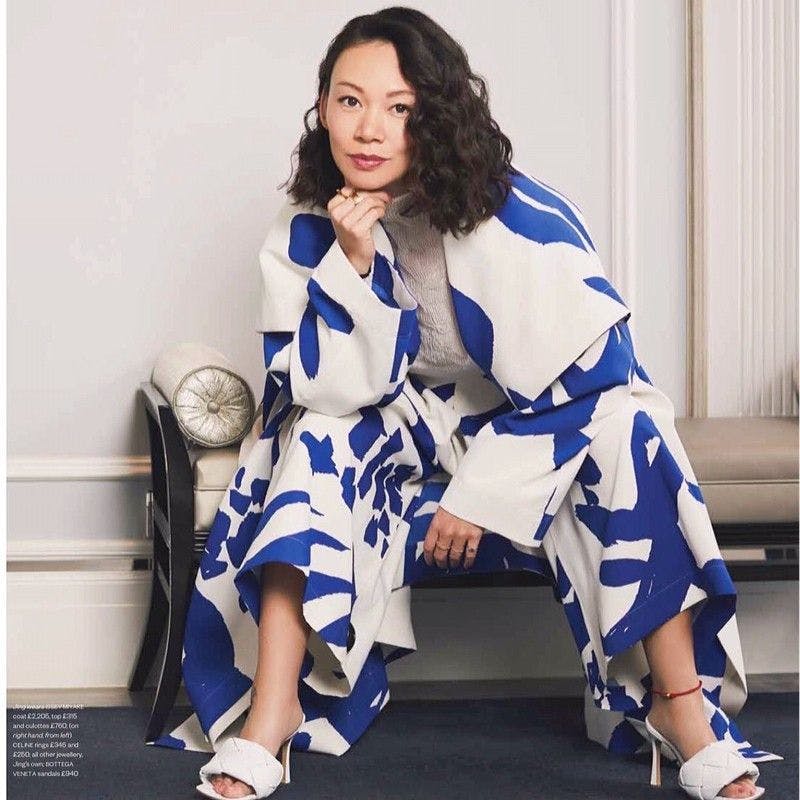When Italian luxury menswear giant Zegna announced a collaboration with The Elder Statesman, a niche Californian bastion of bohemian chic, many were surprised. But a look at the collection reveals that luxurious European sartorial precision and playful West Coast laid-back chic can make for a compelling men’s wardrobe – all in cashmere.
It's all part of the younger, fresher Zegna that Artistic Director Alessandro Sartori has crafted in the past seven years at the brand’s creative helm.
“Just to give you a number, the average customer that buys items with the triple stitch in some cities like London, is now from 32 to 35 years old. This is very different from where we were 10 years ago,” says Sartori during an interview last month at the Temple House hotel in Chengdu during the Asian leg of his collaboration tour. Next up is Singapore’s F1 and then, Hong Kong.
The approach is clearly working business-wise. The Ermenegildo Zegna Group adjusted EBIT grew 47.8 percent YoY to 100.5 million euros (106 million) in H1 2023, and the group reported 1.5 billion euros (1.6 billion) in revenue last year. This performance may just hold up against the backdrop of a luxury slowdown in the US and macro-economic woes in China.

How to thrive in luxury menswear#
“The market after the pandemic reacted with a more meaningful mindset. And with a very interesting, modern approach,” Sartori tells Jing Daily.
Many men’s fashion brands, leaning on logos, hype and trends, have suffered during and post pandemic. But it’s the quiet luxury labels like Zegna, Brunello Cucinelli, Tods and Loro Piana that have boomed, as wealthy clients refocus their tastes, and wallets, towards higher quality, brand values and comfort-driven consumption.
“One of the reasons Zegna had very strong traction in the last two years is because we got to the market with the right product just before people needed that product,” he adds. “And we're doing it in a very honest way, delivering a very real, quality product. And most of all, a new modular system for styling,” where the focus, unlike most of high fashion, isn’t about full looks, but about versatile mixing and matching for easier dressing.
The Chinese male consumer, for whom Zegna has been a coveted brand since entering the market in 1991 (the first luxury brand to do so), has been historically different from his Western counterpart, starting luxury consumption at a younger age and preferring less traditional options.
“They are more fresh and more willing to change and to get into this new lifestyle,” says Sartori, who has visited Greater China several times since international borders fully opened at the start of this year. “This market is very fast and extremely fascinating.”

Indeed, the brand’s CEO Gildo Zegna told audiences at a 2018 WWD Apparel and Retail Conference that the country was a site for innovation: “We test new things in China first. If it works, we bring it to the world.”
This adaptability makes the Chinese audience a receptive one for the Zegna x The Elder Statesman capsule. As of June this year, Zegna directly operates 122 stores and 35 wholesale stores in the APAC region, a market that has boosted luxury revenues as US demand slows.
Meeting of minds#
Oasi Cashmere is sourced from “a select group of farmers in Mongolia,” and in The Elder Statesman collab, comes in vibrant statement hues, and playful, organic patterns. It’s also a nod to a new way of dressing: a bright cashmere beanie paired with a crisp Zegna suit, for instance, or a soft, bright robed jacket worn with wide cut trousers – all best appreciated by touch.
Sartori met The Elder Statesman founder Greg Chait (“a very interesting man with a very profound soul”) three years ago. Founded in 2007, the Californian label embodies a breezy, free-spirited aesthetic – think relaxed silhouettes, eclectic patterns, and artisanal dyes.
“I remember discovering this brand, this very colorful collection,” Sartori tells Jing Daily. “But one point that really attracted me was that every garment was made in a small quantity in their downtown LA factory, where everything is done by hand … There is this feeling that the pieces are crafted by someone's grandmother.”
On the other side of the Atlantic, Zegna's story is woven through more than a century of Italian tailoring, fabrication, and menswear finesse. From humble beginnings in Trivero, a small town in northern Italy, the family-run brand has grown into a global menswear powerhouse.
There’s a softening of Zegna’s usually more structured silhouettes in the collaborative collection. Cashmere color palettes combine earthy, virgin tones from the 100-plus square kilometers of nature reserve at Oasi Zegna alongside bright, and ombre hues reminiscent of Malibu sunsets and California seascapes are found on cashmere slacks, robe jackets, bucket hats, alpaca and wool slippers. This is dopamine-spiking dressing at its finest.
“It’s like seeing Zegna through the eyes of a Californian designer. But at the same time, we're doing some linear models like the overshirt, outerwear, or a fabric, like the cashmere plaid,” says Sartori.

Sustainability: A shared vision#
Far from a fleeting romance, the two brands have created a union of cultural touchpoints and craft, and also eschewed some menswear norms.
The crux of the collaboration is that this cashmere will be fully 100 percent traceable by 2024, a feat made possible through the Italian brand’s fully integrated supply chain that goes “from the source to a final product,” Sartori says.
“It means you can control the quality, you can ask for exclusivity, and you can develop things you don't find elsewhere in the market,” he says.
Sustainability has anchored the collaboration. The Elder Statesman sources ethically, produces small runs and champions artisanal craftsmanship. Zegna, through its “Use the Existing” initiative, champions the transition to renewable energy, which has seen the Group’s emissions decline, and increased transparency.
As for Sartori, one post-pandemic change is that he’s stopped designing for the fashion seasons: “We have a longer journey. I'm talking to a broader audience of customers with a very interesting new approach.”
Garments are conceived with three layers. “Aesthetic functionality, durability, and they need to go together,” he says. “It means that we don't do anything that doesn't last as long as possible. So double or triple stitching, special techniques to put together and to assemble the pieces, different concepts for the construction, much less interlining – all to maximize longevity.”
Today, sustainability is emerging as a signifier of true luxury – a rebuke to the designed obsolescence that plagues so much of the fashion industry and the environment.
The Zegna x The Elder Statesman project isn’t just about interweaving two aesthetics, or two hot brands – it’s a gentle nudge to the industry, signaling that the future of fashion lies in meaningful collaborations, shared sustainable values, and a vision that looks beyond borders, while having a lot of fun.



